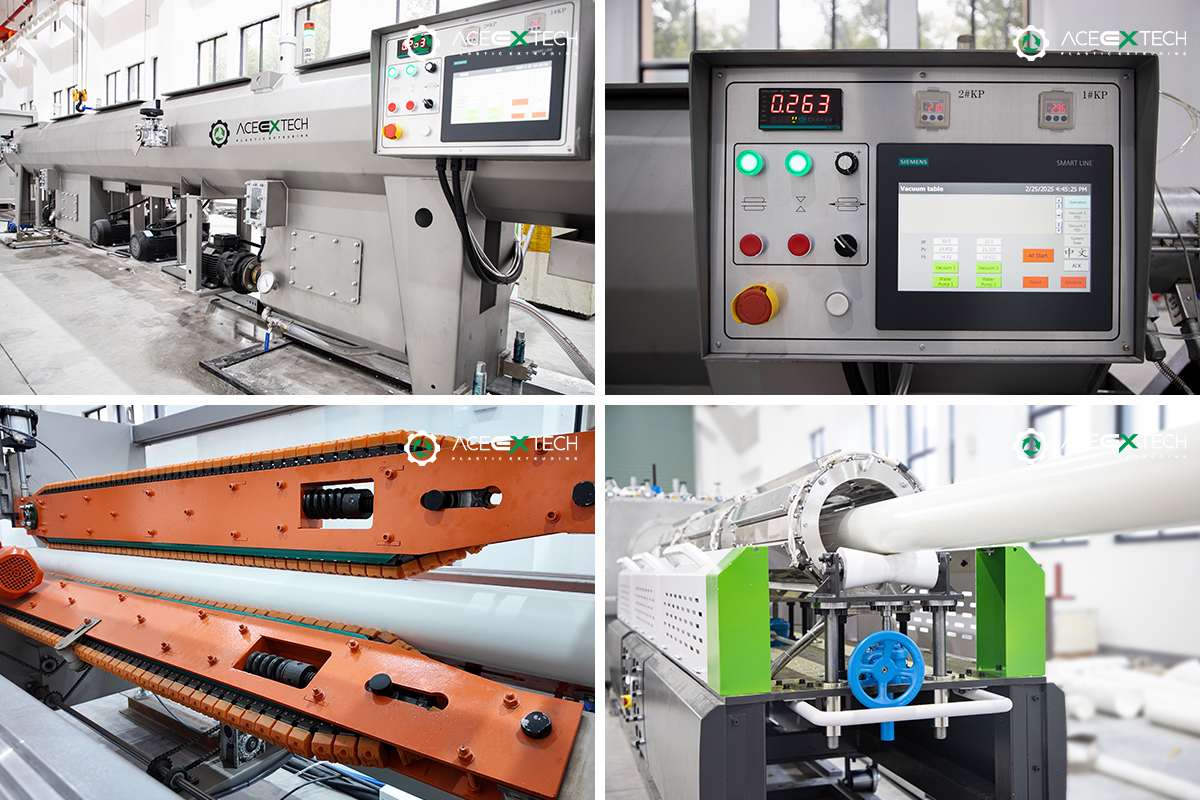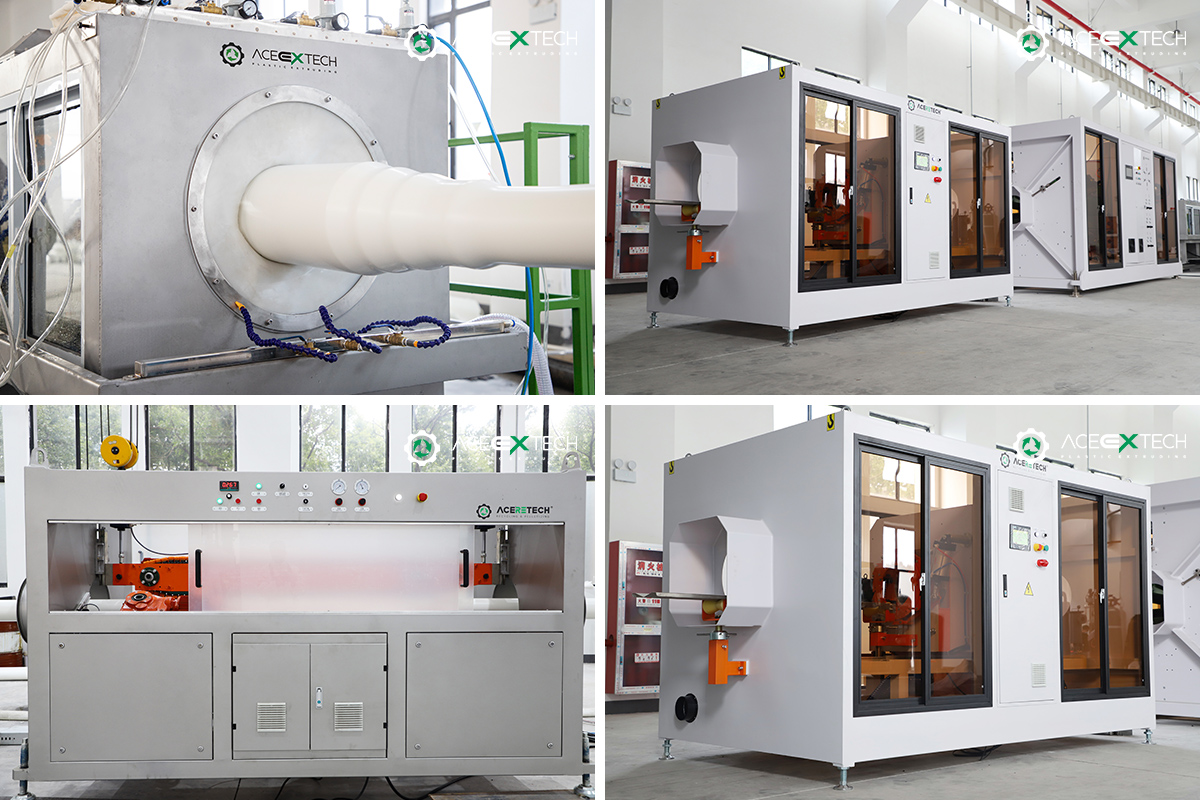Introduction
OPVC (oriented polyvinyl chloride) plastic pipe extruder is the core equipment in modern plastic pipe production, especially suitable for the production of large-diameter pipes. This article will focus on the complete extrusion production line for producing 250mm diameter OPVC pipes, including the functions and applications of key equipment such as mixer, extruder, die head, vacuum tube, tractor, infrared heater, water cooling spray box and cutting machine.
1. Mixing system
The mixer is the first process in the production of OPVC pipes. Its function is to evenly mix PVC resin with various additives. For the production of 250mm large-diameter pipes, special attention should be paid to the mixing system:
Use a combination of high-speed hot mixer and cold mixer to ensure uniform dispersion of materials
Strictly control the mixing temperature (hot mixing is about 120°C, cold mixing drops to below 40°C)
Add appropriate amount of stabilizer, lubricant and modifier to the formula
The mixed material needs to be matured for more than 24 hours to ensure full penetration of additives
2. Extruder system
The extruder is the core equipment of the production line, which is used to melt and plasticize the mixed materials and extrude them:
Usually a parallel twin-screw extruder is used, and the screw diameter is selected according to the requirements of 250mm pipes. The length-to-diameter ratio (L/D) is generally 24:1 to 30:1 to ensure full plasticization
The barrel temperature is controlled in sections, and the temperature gradually increases from the feeding section to the head (160-190°C)
Equipped with a melt pump and a melt pressure sensor to ensure extrusion stability
3. Die head design
The die head is the key component that determines the dimensional accuracy of the pipe. The design points of the 250mm large-diameter pipe die head are as follows:
The spiral diversion bracket die head is used to eliminate the parting line
The die head flow channel needs to be optimized to ensure uniform melt flow
The die gap is usually 10-20% larger than the pipe wall thickness, considering the expansion and stretching effect of mold release
The die head temperature is controlled at 190±5°C, and each zone is independently controlled
Equipped with a die head heating ring and a thermocouple, the temperature fluctuation is controlled within ±1°C
4. Vacuum sizing system
The vacuum sizing tube (vacuum box) is used for the initial forming and sizing of the pipe:
The length of the vacuum box is usually 6-8 meters, which meets the cooling requirements of 250mm large-diameter pipes
The vacuum degree is controlled at -0.06~-0.09MPa, adjusted according to the wall thickness of the pipe
Adopt multi-stage vacuum control, the vacuum degree in the front section is higher, and the vacuum degree in the rear section gradually decreases
The inner wall of the sizing sleeve needs to be kept smooth to reduce friction resistance
Equipped with an automatic water level control system to ensure uniform cooling
5. Hual off
The hual off provides stable traction for the pipe to ensure continuous production:
The crawler
hual off
is used, and the traction must meet the requirements of 250mm pipes
Equipped with variable frequency speed motor, the speed and extrusion volume are accurately matched
The traction speed is usually 0.5-3m/min, adjusted according to the pipe specifications
The clamping block is made of soft material to avoid damage to the pipe surface
The traction pressure is adjustable to ensure no slipping and no overpressure
6. Infrared heating system
The infrared heater is used for secondary heating and molecular orientation of pipes:
Located behind the vacuum sizing box, it is used for secondary heating of OPVC pipes
The heating temperature is controlled above the glass transition temperature of PVC (about 80-100°C)
Infrared heating is uniform, and local precise temperature control can be achieved
After heating, the pipe enters the secondary stretching stage to form a molecular orientation structure
Equipped with a temperature feedback system to automatically adjust the heating power
7. Water cooling spray box
The water cooling system is used for the final cooling and shaping of the pipe:
The length of the spray box is usually 12-16 meters, which meets the cooling requirements of 250mm pipes
The multi-stage spray design is adopted, and the water temperature is reduced step by step
The water temperature in the first stage is about 40-50°C, and the last stage drops to 15-25°C
The spray pressure is uniform to avoid deformation of the pipe
Equipped with water circulation and temperature control system to save water
8. Cutting machine
The cutting machine is used to cut the continuously extruded pipe according to the set length:
For 250mm large-diameter pipes, a planetary cutting machine is used
The cutting length is adjustable, and the accuracy is controlled within ±2mm
The cutting process is tracked synchronously to ensure that the cut is flat and vertical
The saw blade is made of carbide and has a long service life
Equipped with a dust suction device to keep the working environment clean
Production of 250mm Key points of OPVC pipe process
Temperature control: The temperature of each section from extrusion to cooling needs to be precisely controlled, especially the temperature of the die head and infrared heating zone
Speed matching: The extrusion speed, traction speed and cutting rhythm need to be coordinated
Vacuum control: The vacuum degree directly affects the roundness and dimensional accuracy of the pipe
Cooling gradient: Spray cooling needs to form a reasonable temperature gradient to avoid stress concentration
Quality control: Online monitoring of pipe outer diameter, wall thickness and ovality and other parameters
Conclusion
The 250mm OPVC plastic pipe extrusion production line integrates multidisciplinary technologies such as mechanical, electrical, thermal and automatic control. With the advancement of polymer material technology and equipment manufacturing technology, modern OPVC pipe extruders are developing in the direction of high efficiency, high precision, low energy consumption and intelligence. Reasonable configuration and optimization of each unit equipment and mastering key process parameters are the key to producing high-quality large-diameter OPVC pipes.